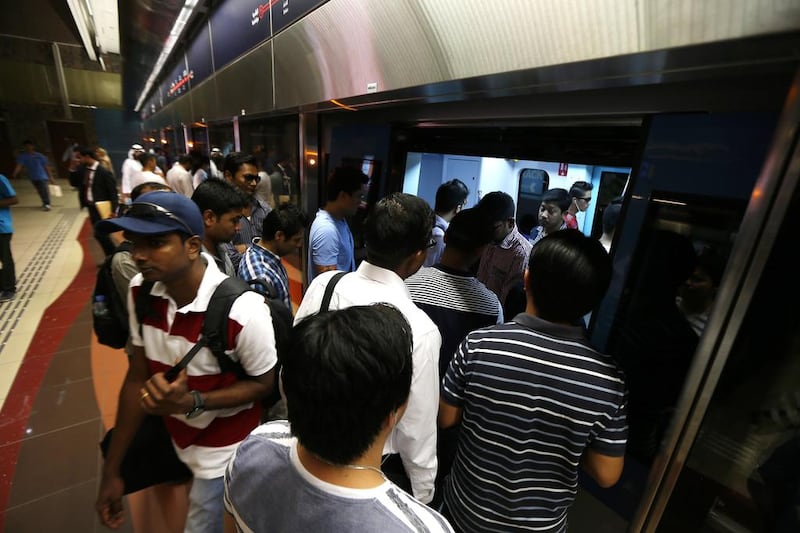DUBAI // The doors to the train slide open but before the travelling passengers can properly disembark, they are pushed back by a tide of people trying to get on board.
The scene is a familiar one, repeated at dozens of the busiest Dubai Metro stations across the Red and Green lines. It is also one of the key etiquette issues that officials have been trying to tackle for more than two years.
In 2012, notices were put up telling passengers on the platform to wait to one side of the train doors to allow people on the train to disembark first.
Yet, regular metro passengers see the warnings ignored outright.
“It’s the biggest problem for me and why I sometimes think twice about catching the metro,” said Aurelie Allard, 35. “The worst time was when I couldn’t get off because I was pushed back so far in the train I missed my stop. I stopped catching the metro for a few years after that.”
The French woman said certain stations, such as Union and Burjuman, were worse than others.
The Roads and Transport Authority said it carried out a study several years ago that found the issue among the biggest complaints metro users had of the service.
Commuter I J said it comes down to a difference in public transport cultures. “I remember when I was in Delhi and I used to catch the metro to work, everybody would rush on the train to find the empty seats,” he said. “The problem could be easily solved if there are more carriages on the Dubai Metro.
At the moment, if you stand back very nicely to let others on the train first you will end up standing for over an hour on the train.”
The RTA has also published a list of other etiquette points, including not to push, to move along the platform and to respect personal space.
In many stations, public address systems urge people not to block the doors of the ticket barrier.
However, commuters have a long list of other points they would like to see as universal.
Steve Turner said on the London Underground it was common for people to stand to the right side of the escalator, leaving the left free for people to freely walk up or down if they wish.
“I can’t count the number of times I’ve been in a rush and the travelator has been blocked by people just standing around,” he said. “They need to implement a fast lane for people who want to walk quickly. You shouldn’t have to constantly ask people to move out of the way.”
The UK's Daily Telegraph newspaper said that the Dubai Metro had "skimpy" etiquette rules when compared with other countries. In Seoul, passengers were requested to "stand in four lines to prevent crowding". In Paris, it is an unwritten rule to not use the fold-down seats if the train is crowded.
The BBC even prepared a lengthy, tongue-in-cheek guide to London Tube etiquette that states: “On no account does a person make eye contact with another passenger on the underground, in any circumstance, even accidentally.”
However, it is not all doom and gloom. Annette Taylor said when she was riding the metro while pregnant last year, there was no shortage of chivalry. “There’s no real rules about giving up your seat for pregnant women here,” said the Brit. “But as soon as I got on the metro, someone would give me their seat. It was really nice. Sometimes I still wish I was pregnant.”
mcroucher@thenational.ae






